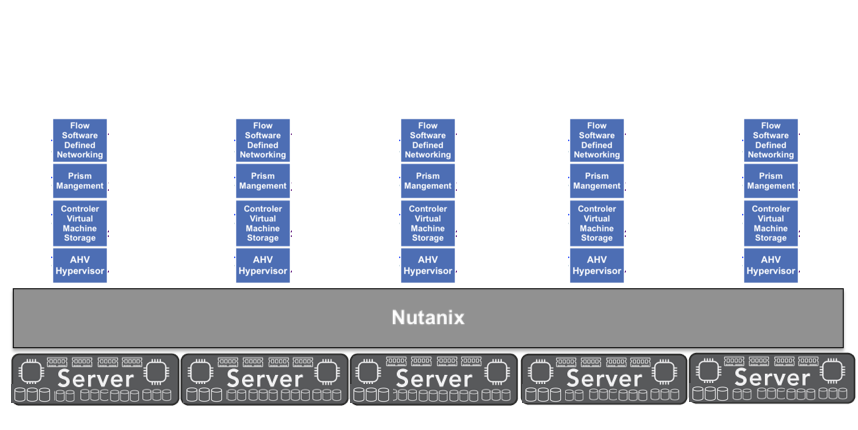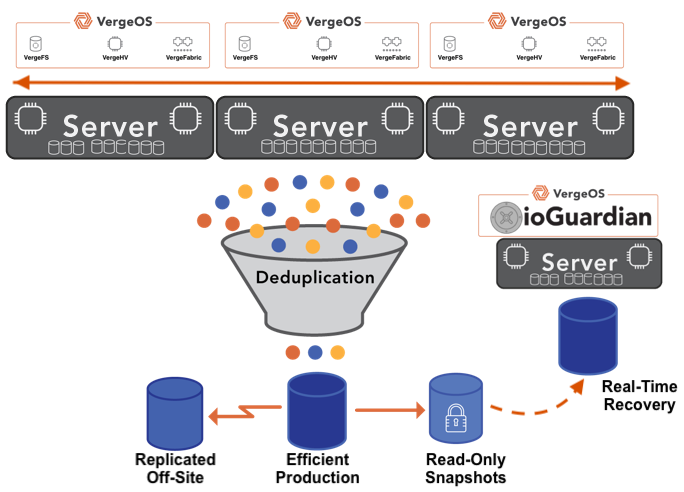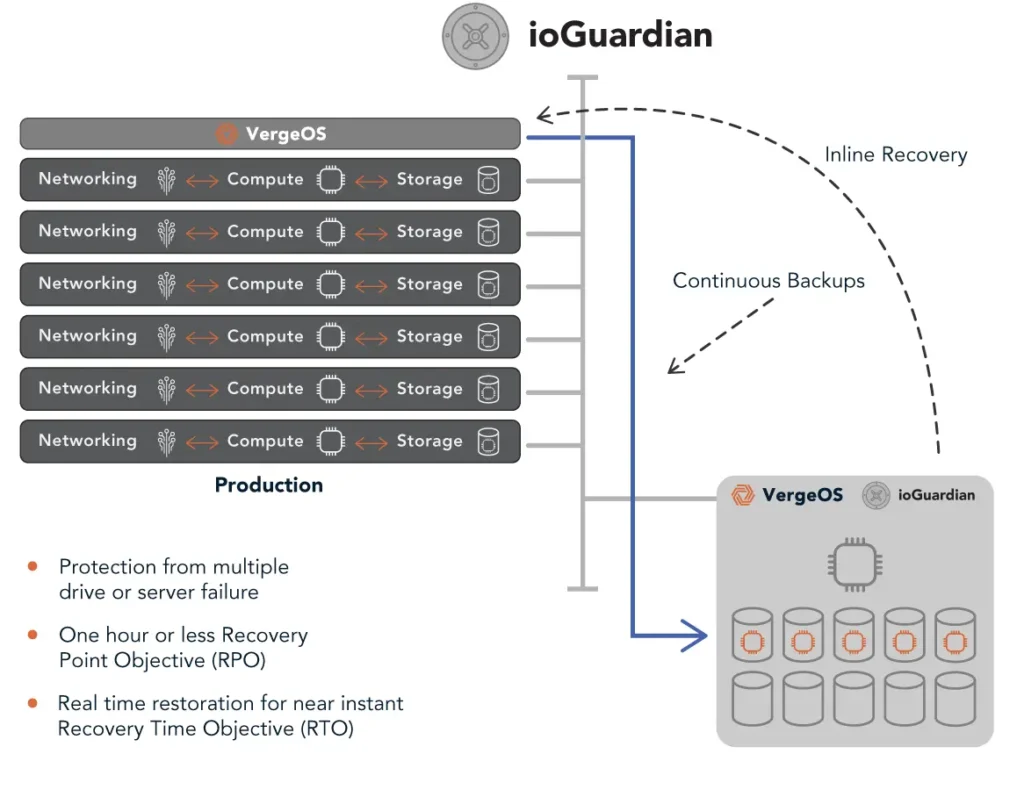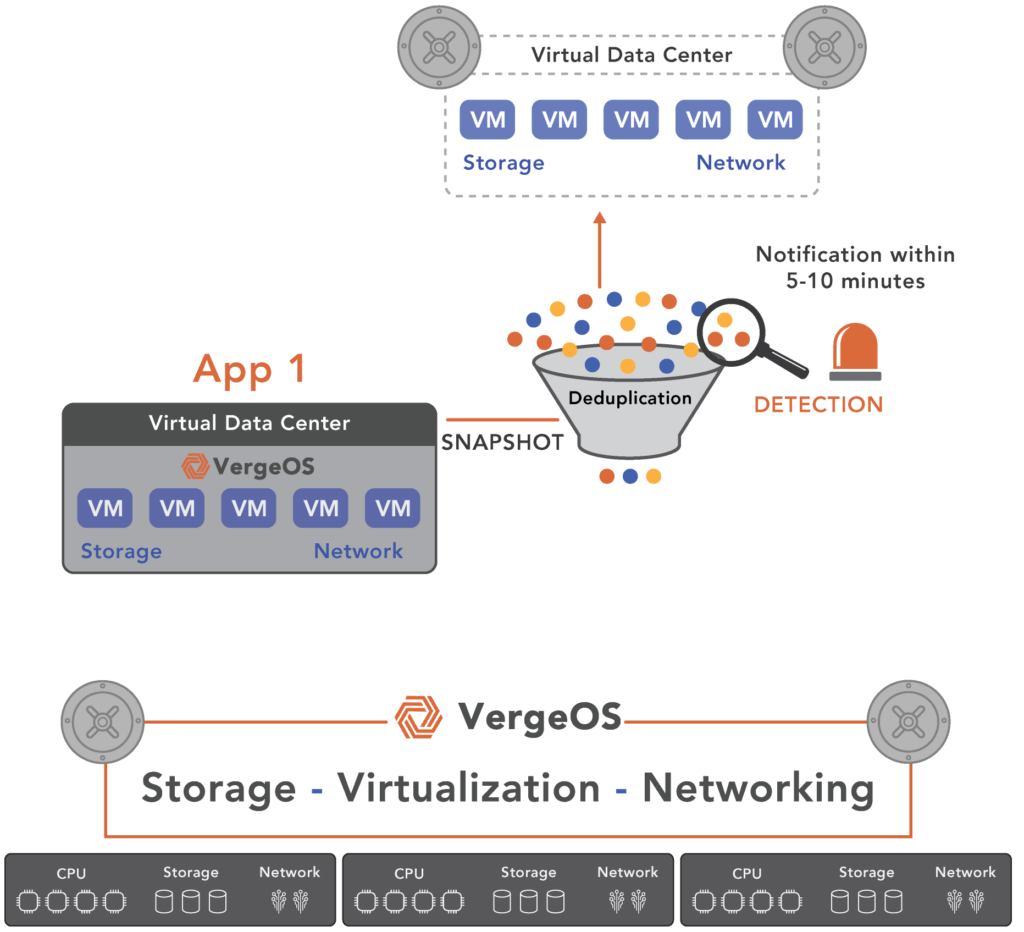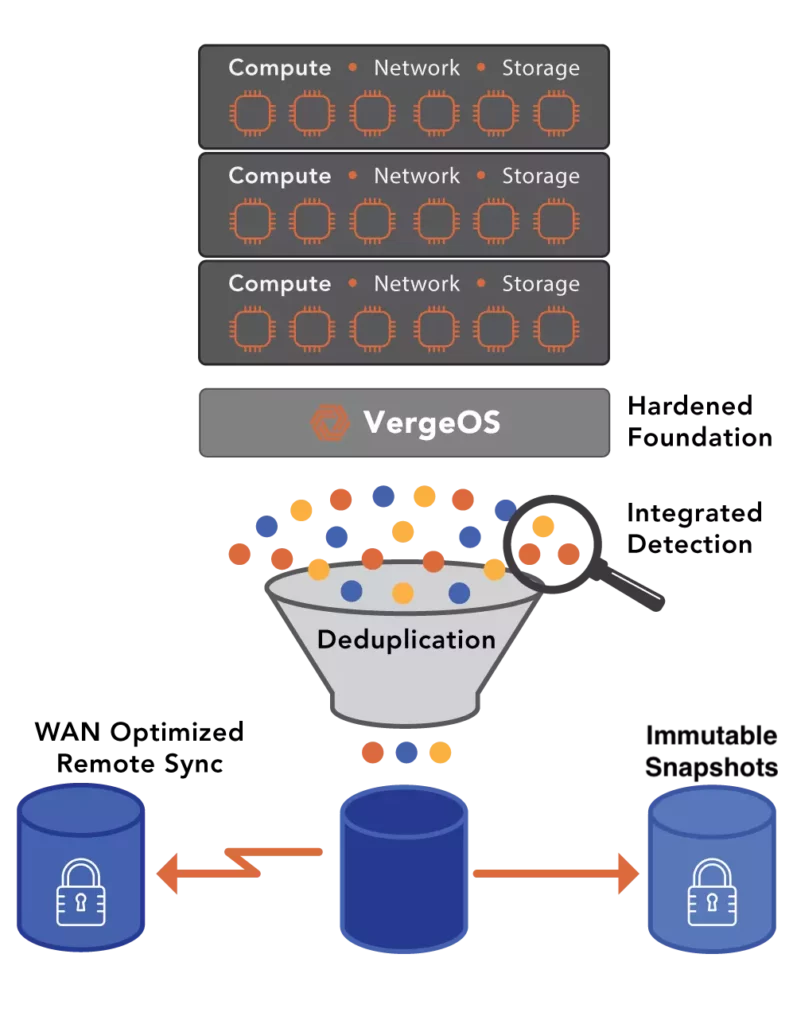The hidden costs of HCI often prevent IT professionals, who are looking to exit VMware, from seriously considering the architecture as a viable alternative. Hyperconverged Infrastructure (HCI) vendors capitalize on this scenario, positioning their solutions as streamlined platforms that seamlessly unify virtualization, compute, storage, and networking. However, this initial promise of simplified infrastructure management frequently masks significant hidden costs and complexities.
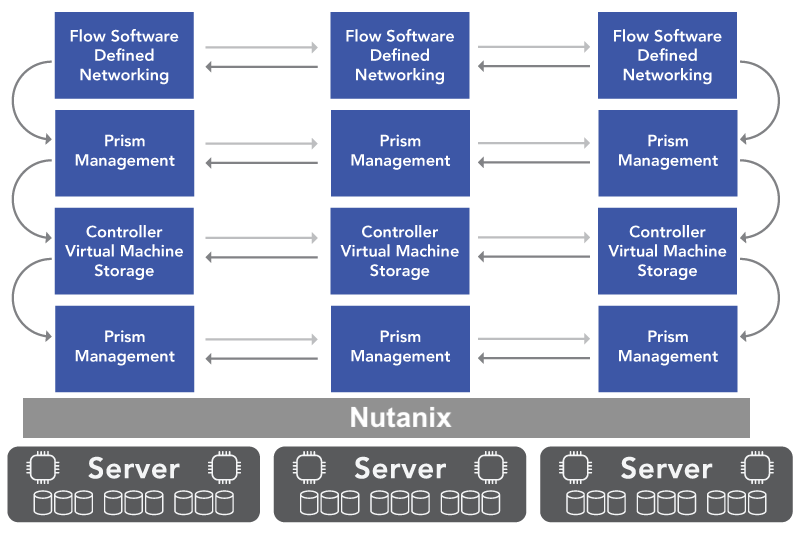
Initially intended to unify infrastructure components, traditional HCI has failed to deliver true integration. Compute, storage, and networking resources remain operationally separate, requiring distinct layers in the form of virtual machines (VMs) communicating with the hypervisor. Commonly deployed solutions utilize separate VMs for storage management (e.g., Nutanix’s CVM or VMware’s vSAN), distinct networking stacks (Nutanix Flow, VMware NSX), and individual management VMs (Nutanix Prism, VMware vCenter). True operational simplification remains elusive; what began as convergence is merely the virtualization of legacy three-tier architectures.
How VergeOS Solves the Convergence Problem
VergeOS achieves true convergence through its ultraconverged design. By integrating storage, networking, virtualization, and data services directly into a unified operating environment, VergeOS eliminates silos and redundant communication layers. This cohesive design simplifies operations, reducing complexity, administrative overhead, and resource inefficiency.

Dive deeper with our on-demand webinar: “Comparing HCI as VMware Alternatives.”
The Efficiency Problem
The hidden costs of HCI include its inability to deliver meaningful infrastructure efficiency. Despite sharing hardware, HCI components remain distinct entities, each consuming substantial resources. Dedicated storage VMs, management VMs, separate networking stacks, and additional abstraction layers cumulatively drain compute cycles and memory. Application VMs running within these infrastructures consequently suffer degraded performance and higher latency, forcing organizations to compensate with additional hardware investment rather than benefiting from the initially promised efficiency gains.
For instance, a typical I/O operation in an HCI environment begins at the hypervisor level, proceeds through a storage controller (virtualized as a separate VM), traverses network infrastructure, and finally reaches physical storage media. Each extra step consumes CPU resources, adds latency, and reduces performance efficiency. As workloads scale, the cumulative impact of these inefficiencies affects application responsiveness and resource utilization.
Some HCI vendors utilize data locality to mitigate some of these issues; however, this technology further complicates operations and negatively impacts performance during node or drive failure.
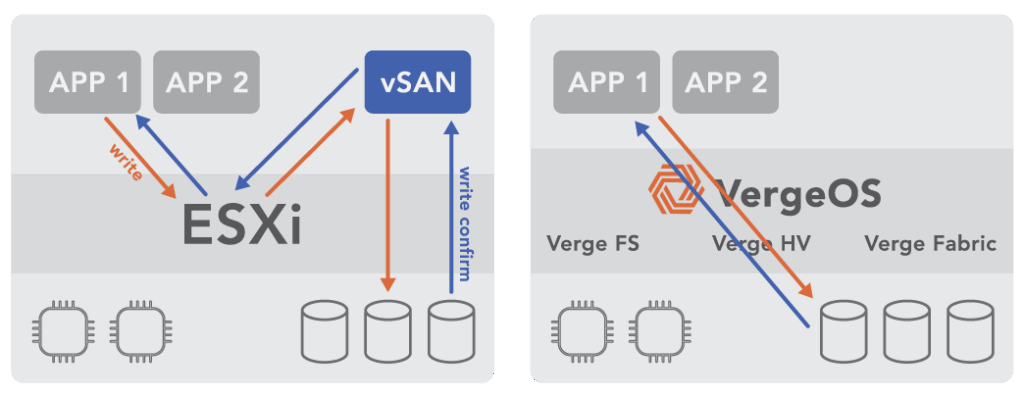
How VergeOS Solves the Efficiency Problem
VergeOS integrates all services, including storage and networking, directly into its operating system, eliminating performance overhead associated with separate management virtual machines or additional software layers. Its lightweight architecture ensures maximum resource efficiency, optimizing performance and dramatically reducing hardware requirements and infrastructure costs.
The High Cost of HCI Inefficiency
The hidden costs of HCI inefficiencies necessitate significant investment in higher-performance hardware to compensate for architectural shortcomings. IT must procure more powerful servers, increased core counts, expanded memory, and faster networking. Furthermore, licensing models that charge per CPU core or capacity exacerbate costs, forcing organizations into substantial capital expenditures. These license models compel customers to purchase less optimal hardware to contain software licensing costs.
How VergeOS Reduces the Cost of Inefficiency
With a streamlined architecture, VergeOS maximizes hardware resource utilization. Its efficient code base and integrated design enable organizations to achieve optimal performance using commodity or existing hardware, reducing initial capital expenditures and ongoing operational expenses. VergeIO licenses VergeOS per-server without penalties for using high-core-count or high-capacity servers.
The High Cost of HCI Data Availability
HCI solutions employ synchronous mirroring—continuous real-time data duplication across nodes—to protect against hardware failures. Vendors commonly refer to redundancy levels as Replication Factor (RF) or Fault Tolerance Level (“failures to tolerate” or FTT). Nutanix refers to protection from one node failure as Replication Factor 2 (RF2), meaning two copies of data are maintained. VMware terms this configuration Failures to Tolerate of 1 (FTT=1).
To protect from two simultaneous node failures or multiple drive failures across nodes, Nutanix uses Replication Factor 3 (RF3)—three data copies—while VMware uses FTT=2. This triple redundancy greatly increases storage capacity and resource requirements. RF3 requires at least five nodes, becoming prohibitively expensive for smaller deployments. In larger environments, limiting resiliency to two node failures is insufficient, as risk increases with node count.
These requirements force prioritizing specific workloads for enhanced protection (RF3), relegating others to standard availability (RF2). Limited redundancy beyond RF3 leads organizations to increase the cluster count per site, resulting in cluster sprawl, which in turn causes additional administrative complexity, higher costs, and uneven availability guarantees.
To maintain performance during node failures, Nutanix and VMware require reserving a portion of resources on each server equal to the capacity of one full node. In a four-server environment, 25% of each server’s resources are reserved for failover, which substantially reduces the available capacity during regular production operations.
How VergeOS Delivers Cost-Effective Data Availability
VergeOS leverages ioGuardian, a deduplicated third-copy data protection method. This efficiently safeguards against multiple simultaneous hardware failures without excessive storage overhead or node count requirements of traditional RF3 implementations. ioGuardian provides robust availability at an economical cost, without requiring workload prioritization, delivering superior resilience at a lower price and complexity.
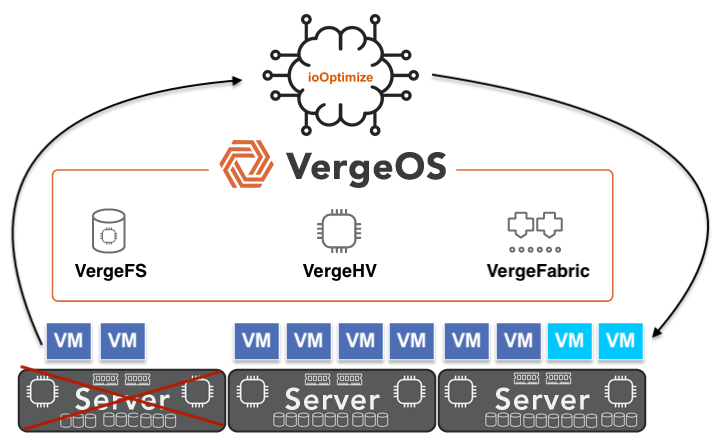
No reservation of server resources is required. If a node fails, VergeIO’s ioOptimize technology intelligently and automatically reallocates affected VMs to other nodes based on each VM’s resource demands and available server capacities.
The High Cost of HCI Data Protection
The Practice of Snapshotting
Snapshotting commonly provides additional recovery points beyond the capabilities of backup software. However, snapshot-intensive environments impose severe performance penalties, resulting in increased storage I/O and network resource demands. Frequent snapshots or long-term snapshot retention require complex metadata management, demanding more powerful servers, additional memory, and faster storage media. This results in escalated hardware and licensing costs, especially in per-core or per-capacity licensing models common to HCI.
Snapshot chains or numerous simultaneous snapshots greatly increase complexity, hindering disaster recovery processes. Restoring across heterogeneous hardware or hypervisor environments becomes challenging, restricting operational flexibility.
How VergeOS Simplifies Data Protection

VergeOS utilizes ioClone technology, integrated with its global inline deduplication, to create space-efficient, independent snapshots with minimal metadata overhead. ioClone’s architecture supports near-continuous snapshot execution and indefinite retention without performance degradation, enabling rapid and efficient data protection without the need for costly hardware upgrades or complex snapshot management. The combination of ioGuardian and ioClone also reduces the organization’s dependency on backup, lowering the costs of backup software licensing and backup hardware infrastructure.
The High Cost of HCI Inflexibility
The hidden costs of HCI architectures imposing strict hardware compatibility and homogeneity requirements are significant. Expanding storage or compute resources mandates identical hardware, limiting flexibility and increasing long-term infrastructure costs. Adding nodes of different brands, generations, or capabilities creates additional clusters, which fragment management and reduce efficiency.
How VergeOS Enhances Infrastructure Flexibility
VergeOS supports heterogeneous hardware environments, enabling organizations to integrate diverse hardware configurations into unified, scalable clusters seamlessly. This flexibility reduces costs, simplifies expansion, and maximizes investment longevity, enabling adaptive infrastructure growth without imposed constraints on homogeneity.
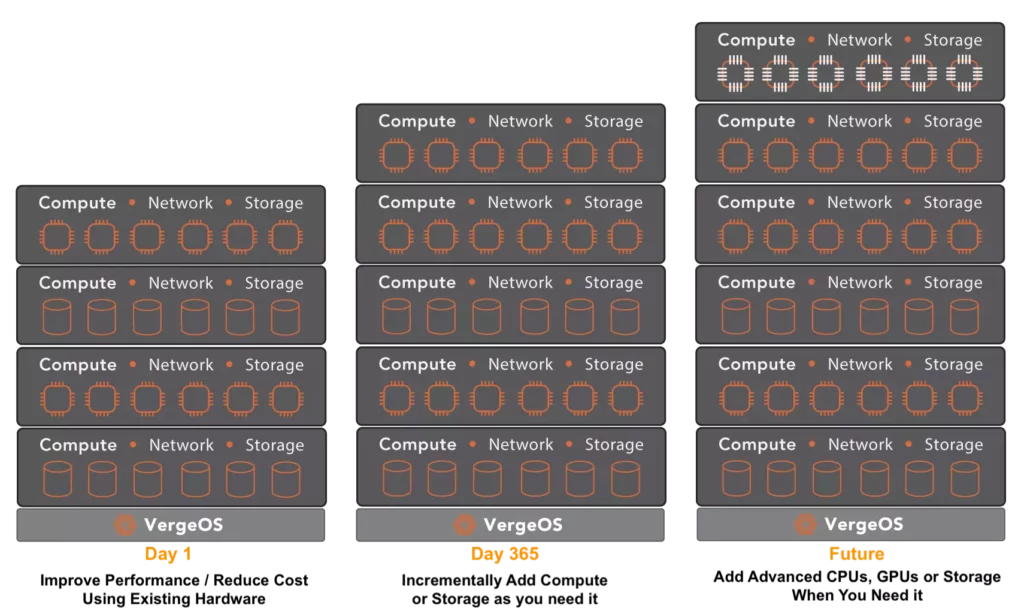
An Example of The Hidden Costs of HCI vs. VergeOS
Consider a three-node infrastructure using traditional Hyperconverged Infrastructure (HCI), where the organization’s goal is to maintain continuous data availability even after two simultaneous node failures. Traditional HCI solutions, such as Nutanix or VMware vSAN, require at least five nodes configured with Replication Factor 3 (RF3), or a Fault Tolerance Level of 2 (FTT=2), ensuring continuous availability despite two node failures. In addition, these solutions require maintaining sufficient free storage capacity at all times to accommodate a complete rebuild in the event of node failures, thereby reserving capacity equivalent to an entire node, which further reduces usable storage space.
Because the customer wants to leverage their existing hardware—a heterogeneous mix of Dell and HPE servers—traditional HCI platforms present immediate compatibility and cost challenges. Traditional HCI requires uniform hardware for seamless operation, which adds complexity and cost.
Cost Analysis for Traditional HCI
Achieving protection from two simultaneous node failures requires:
- Minimum Node Count: 5 nodes (uniform hardware required).
- Replication Method: RF3 or FTT=2 (three synchronous copies of all data).
- Usable Capacity: Reduced to approximately 33% due to triple mirroring overhead.
- Reserved Free Capacity: Additional storage space equal to one node’s full storage capacity, always kept available to allow immediate rebuilds after failures.
In this scenario, the customer faces:
- The necessity of purchasing additional uniform hardware due to vendor compatibility guidelines.
- Higher software licensing costs, typically calculated per CPU core.
- Significant reserved resources on each node (compute and storage) are allocated exclusively for node failure scenarios.
This dramatically increases capital and operational expenses, requiring significant investment in new hardware and licenses, thereby negating the anticipated HCI savings.
Cost Analysis with VergeOS
In the same scenario, VergeOS offers substantial advantages:
- Minimum Node Count: 3 nodes (uses existing Dell and HPE hardware).
- Replication Method: Integrated distributed mirroring combined with VergeOS’s independent, deduplicated third data copy via ioGuardian, which can be installed on any available standby server.
- Usable Capacity: Approximately 50% (due to two-way mirroring), augmented by ioGuardian’s deduplication efficiency.
- Reserved Free Capacity: Minimal additional storage capacity needed due to ioGuardian’s efficient data protection strategy, reducing rebuild space requirements compared to traditional RF3 architectures.
With VergeOS, you benefit from:
- No need for uniform hardware, allowing immediate use of existing Dell and HPE servers.
- Reduced licensing and hardware costs, as no additional nodes or extensive resource reservations are required.
- Enhanced data availability beyond traditional two-node failure protection without extensive reserved storage, reducing overhead and complexity.
Summary of Cost Benefits
Traditional HCI requires two additional nodes (totaling five) and mandates uniform hardware, increasing both capital and operational expenses, compounded by large reserved capacity requirements for rebuilding data. VergeOS provides superior resilience, operational continuity, and cost efficiency by leveraging existing heterogeneous hardware and substantially reducing the need for reserved rebuild capacity.
Conclusion
While hyperconverged infrastructure initially promises simplicity, efficiency, and cost savings, underlying architectural limitations quickly surface as substantial hidden costs. Challenges such as insufficient convergence, operational inefficiencies, costly availability and protection schemes, and restrictive infrastructure flexibility erode promised benefits. Organizations should carefully assess these hidden costs when evaluating HCI solutions, prioritizing converged, integrated infrastructures like VergeOS that fundamentally address these critical challenges, enabling efficient, cost-effective, and future-ready IT environments.
Register for our HCI Data Availability Analysis
